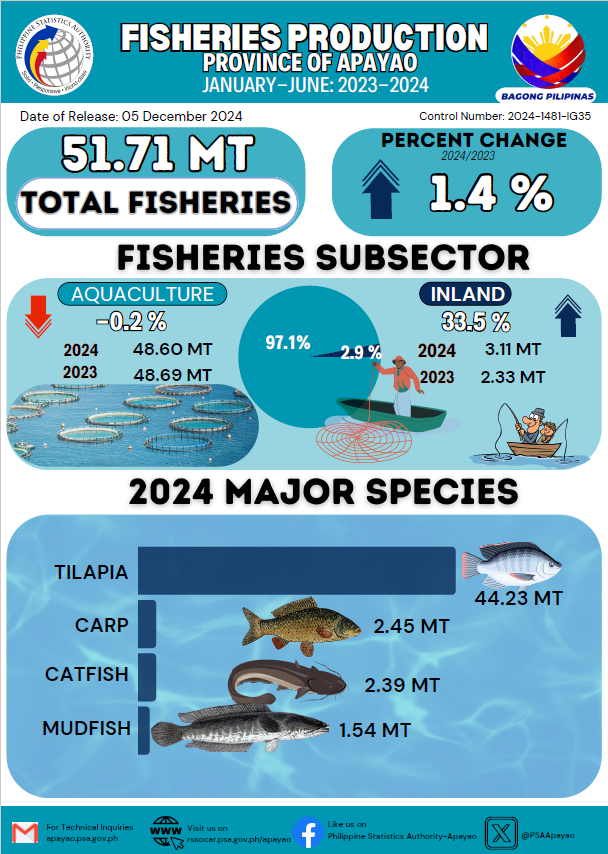The Philippine Statistics Authority (PSA) generates statistics for freshwater municipal aquaculture and inland fishing. Production surveys are conducted quarterly in sample aquaculture farms and sample inland fishing households. The respondents of the surveys are aquafarm operators, fishermen or other knowledgeable members of the household. Generated quarterly fisheries production is included in the quarterly data review process of the PSA at the provincial, regional and national levels. After the data validation, preliminary estimates are made available to data users.
The region’s total fish production from 2014 to 2015 dropped by 2.8 percent or from 3,977 metric tons to 3,866 metric tons. The negative growth was primarily contributed by the decline in municipal aquaculture production due to the onslaught of typhoon “Ineng” that struck the region on the 3rd week of August 2015. Production was also aggravated by the extensive feeding by some pond operators which resulted to smaller sizes of fish harvested (Table 1).
Only the province of Benguet increased in production which was a result of the opening of new fishpond areas in Sablan, Mankayan and Itogon. Operators in these areas were encouraged to expand due to the continuous BFAR intervention in providing technical assistance and fingerlings dispersal to some operators.
Ifugao province was consistently the top fish producer in the region with a share of 46.7% of the total regional production in 2015. Out of the total 1,804 metric tons harvested, 1,552 metric tons (40.1%) came from aquaculture and 252 metric tons (6.5%) came from inland. On the other hand, Mt. Province was the smallest fish producer with 22 metric tons or only 0.6% of the total fish production of CAR (Table 2).
Abra province was the far second from Ifugao with 19% share of the regional fish production, followed by Kalinga with 12.2% share, Benguet with 11.7% share, and Apayao with 9.6% share (Figure 1).
MUNICIPAL INLAND PRODUCTION
- Inland municipal fishing refers to fishing in inland waters like lakes, rivers, dams using simple gears and fishing boats some of which are non-motorized with a capacity of less than three (3) gross tons, or fishing not requiring the use of fishing boats.
- Cordillera municipal inland fishing output in 2015 was 1,173 metric tons, comprising less thana third (30.3%) of the total fish production.
- Abra remained the top inland fishing province with 329 metric tons of fish harvested, which was 28.1% of the total inland fishery. Kalinga trailed with 289 metric tons (24.6%) and Ifugao with 252 metric tons (21.5%). The provinces with the smallest shares were Mountain Province and Benguet with 0.6% and 8.4% shares, respectively.
AQUACULTURE PRODUCTION
- Aquaculture is a fishery operation involving all forms of raising and culturing of fish and other fishery species in fresh, brackish and marine water areas.
- In 2015, Cordillera Administrative Region registered an aquaculture production of 2,693 metric tons with an area harvested of 568 hectares. Aquaculture dominated the region’s fisheries accounting for 69.7% of the total fish production.
- Ifugao posted the highest production with 1,552 metric tons and an area harvested of 216 hectares. Abra was a distant second with 414 metric tons with an area harvested of 155 hectares while Mt. Province has the least production in the Region with only 15 metric tons and an area harvested of 5 hectares (Table 4).
- In terms of percentage distribution in aquaculture production in the region, the largest was Ifugao with 57.6% share. Abra came second with 15.4% share. The other provinces and their share to total aquaculture production were Benguet, 13.2%; Kalinga, 6.8%; Apayao, 6.5%; and Mt. Province with the smallest share of 0.5% (Figure 3).
Technical Notes
Aquaculture - is a fishery operation involving all forms of raising and culturing of fish and other fishery species in fresh, brackish and marine water areas. The operation is comprised of activities from stocking to harvesting of species under controlled conditions in farming facility called aquafarm.
Aquafarm -refers to the farming facilities used in the culture or propagation of aquatic species for purposes of rearing to enhanced production.
Freshwater -is water without salt or marine origin.
Aquaculture Production refers to the volume harvested from the aquafarm during the reference period.
Area Harvested is the actual area which harvests are realized.
Inland municipal fishing is the catching of fish, crustacean, mollusks and other aquatic animal and plants in inland waters like lakes, rivers, dams etc. using simple gears and fishing boats some of which are non-motorized with a capacity of less than three (3) gross tons, or fishing not requiring the use of fishing boats.
Inland municipal Production refers to the volume of catch during the reference period.



